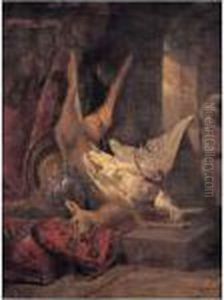Camille Moreau-Nelaton Paintings
Camille Moreau-Nélaton was a French painter and ceramicist who was born on November 9, 1867, in Paris, France. She hailed from an artistic family; her father was the painter and collector Étienne Moreau-Nélaton, and her upbringing was steeped in the arts. This environment influenced her decision to pursue a career in the arts. She was particularly known for her contributions to the Art Nouveau movement, although her work and influence extend beyond this period.
Moreau-Nélaton's work was characterized by a delicate touch and a strong sense of design, often featuring floral motifs and elegant figures. She was skilled in both oil painting and watercolor, but she also gained recognition for her work with ceramics, which was quite innovative at the time. Her ceramic pieces often featured the same naturalistic and floral themes that could be seen in her paintings.
During her lifetime, Moreau-Nélaton exhibited her work at several Salons and was associated with other notable artists of her time. Her artistic career was also influenced by the broader movements of Impressionism and Post-Impressionism, although she maintained her distinctive style. She was not only an artist but also a collector, like her father, and she played a role in the cultural circles of Paris during the late 19th and early 20th centuries.
Camille Moreau-Nélaton's legacy is somewhat overshadowed by the male artists of her era, a common occurrence for women artists of that period. However, her work has been revisited by art historians and collectors in recent years, leading to a renewed appreciation for her contributions to French art and Art Nouveau. Moreau-Nélaton continued to create art until her later years, passing away on May 28, 1947, in Paris.
